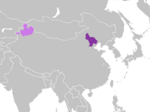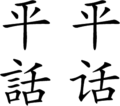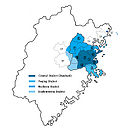A checked tone, commonly known by the Chinese calque entering tone, is one of the four syllable types in the phonology of Middle Chinese. Although usually...
38 KB (3,204 words) - 00:19, 11 November 2024
the historical dark checked tone, though is listed as its own group by others, often due to its more regular light checked tones. Jilu Mandarin is spoken...
63 KB (5,996 words) - 02:01, 21 November 2024
tones in Sichuanese: dark level tone, light level tone, rising tone, departing tone and entering tone (or checked tone). In some regions the checked tone...
32 KB (2,556 words) - 14:47, 1 November 2024
is mid tone in a register system and /˧˧/ is mid level tone in a contour system, or /˧/ may be mid tone on a short syllable or a mid checked tone, while...
111 KB (11,986 words) - 04:25, 25 November 2024
checked tone syllables, only fully voiced consonants still retain the checked tone, while clear and sub-voiced syllables are spoken with a high tone (Chinese:...
3 KB (255 words) - 11:08, 6 March 2024
Northern Wu phonology (section Checked coda)
aspiration conditions a further tone split through the dark tones. Note that, unlike Yue languages, the dark checked tone split is conditioned by aspiration...
45 KB (3,407 words) - 14:16, 22 November 2024
Wu Chinese (section Tones)
typically preserve all voiced initials of medieval Chinese, as well as the checked tone in the form of a glottal stop. Wu varieties also have noticably unique...
110 KB (11,793 words) - 13:14, 21 November 2024
otherwise be checked; for example, the a of tap corresponding to /æ/ whereas that in tape corresponds to /eɪ/. List of phonetics topics Checked tone of Chinese...
7 KB (850 words) - 10:27, 1 September 2024
Beijing Mandarin (division of Mandarin) (section Tones)
dialect group in which checked tone characters with a voiceless initial have dark level, light level, rising and departing tone reflexes. He chose the...
14 KB (1,211 words) - 03:20, 8 July 2024
and entering or checked (入 rù). (The last three are collectively referred to as oblique 仄 (zè), an important concept in poetic tone patterns.) They are...
41 KB (3,101 words) - 10:17, 15 June 2024
Shanghainese (section Tone sandhi)
The checked tones are shorter, and describe those rimes which end in a glottal stop /ʔ/. That is, both the yin–yang distinction and the checked tones are...
79 KB (7,797 words) - 22:28, 4 September 2024
Old Mandarin (section Tones)
However, checked tone syllables (ending in the stops /p/, /t/ or /k/ in Middle Chinese) were all written with a glottal stop ending. (Other tones are not...
30 KB (2,501 words) - 19:47, 4 September 2024
Mandarin Chinese (section Tones)
aspirated and voiced consonants. There were four tones, with the fourth or "entering tone", a checked tone comprising syllables ending in plosives (-p, -t...
85 KB (8,801 words) - 08:53, 22 November 2024
Western Pwo language (section Tones)
pitch of the checked tone is almost the same as that of the falling tone. Therefore, some speakers confuse the checked tone with a falling tone. Giving a...
17 KB (1,160 words) - 08:01, 15 November 2024
Meixian dialect (section Tone)
the following: 陰入 [ ˩ ] a low pitched checked tone 陽入 [ ˥ ] a high pitched checked tone Middle Chinese entering tone syllables ending in [k] whose vowel...
14 KB (798 words) - 20:34, 2 November 2024
are level tones, it's a common convention to use double tone letters for those level tones, and single tone letters for short checked tones, as in Taiwanese...
27 KB (2,812 words) - 15:20, 18 August 2024
consonant, may be called checked, abrupt, clipped, or stopped tones. It has been theorized that the relative timing of a contour tone is not distinctive. That...
5 KB (602 words) - 19:33, 20 April 2024
Hokkien phonology (section Tone sandhi)
and S respectively. Finals with the coda /-ʔ/ are considered to be the checked tone counterparts for the open-vowel finals. /ə/ is not found in Amoy Hokkien...
115 KB (6,601 words) - 22:44, 9 November 2024
Cantonese phonology (redirect from Tones of Cantonese)
three checked tones are separated, the stop codas /p, t, k/ are in complementary distribution with the nasal codas /m, n, ŋ/. Cantonese uses tone contours...
35 KB (2,597 words) - 04:11, 20 October 2024
Burmese language (section Tones)
only on the basis of tone: Low ခါ /kʰà/ "shake" High ခါး /kʰá/ "be bitter" Creaky ခ /kʰa̰/ "to wait upon; to attend on" Checked ခတ် /kʰaʔ/ "to beat; to...
98 KB (9,475 words) - 00:27, 23 November 2024
audible release and may be transcribed as [m̚] of different length and tone. Checked tone Glottal reinforcement Lateral release (phonetics) Nasal release T-glottalization...
9 KB (978 words) - 01:55, 24 June 2024
yinping), Tone 2 (35) (a rising tone or yangping), Tone 3 (32) (slight falling tone or shang), Tone 4 (55) (high even or qu), and Tone 5 (5) (checked tone or...
3 KB (407 words) - 19:57, 13 December 2021
Mainland Southeast Asia linguistic area (redirect from Tone split)
analyses, syllables ending in stops have been treated as a fourth or "checked tone", because their distribution parallels that of syllables with nasal codas...
18 KB (2,130 words) - 12:43, 25 October 2024
Teochew Min (section Neutral tone)
the "dark—light" order (the checked tones are 7 and 8) or in the "level—rising—departing—entering" order (the checked tones are 4 and 8). This section...
79 KB (6,278 words) - 06:26, 17 November 2024
known as nisshō, nissei (入聲, literally "entering voice"), referred to a checked tone, or a syllable that ends in an unreleased plosive (see w:zh:促聲). 促聲 contrasts...
12 KB (1,119 words) - 06:04, 5 November 2024
Fuzhou dialect (section Neutral tone)
assimilation that occurs after them. Although the iòng-ĭk (陽入) tone is also a checked tone composed of both types of syllables, in -k and in -h, there is...
64 KB (5,133 words) - 13:53, 22 November 2024
also have a distance-neutral demonstrative 搿, which is etymologically a checked-tone derivation of 個. In lects such as Shanghainese, distance-based demonstratives...
23 KB (2,611 words) - 21:19, 25 October 2024
readings Go-on: an earlier type of reading Tō-on: a later type of reading Checked tone Miyake, Marc Hideo (2003). Old Japanese: A Phonetic Reconstruction. Routledge...
5 KB (238 words) - 19:07, 9 August 2024













